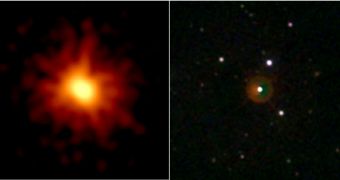On March 19th, NASA's "Swift" satellite photographed a powerful stellar explosion half-universe away from Earth, which broke every known record for the farthest object spotted with the naked eye. Researchers have been trying to shed light on the importance of the event ever since.
Its redshift (an astronomical measure of the distance to a space object) was calculated to be 0.94 (7.5 billion light years away), which means that what we saw in March happened 7.5 billion years ago. The universe was half its age and Earth, the sun, as well as many other cosmic bodies were yet to be born. GRB 080319B, as the burst was called ("B" because it was the second blast recorded that day), has been located in the Boötes constellation.
The majority of gamma ray bursts happen as giant stars' reserves of nuclear fuel run out. Then their cores collapse and form black holes or smaller neutron stars, delivering an intense blast of high-energy gamma rays and ejecting jets of particles in space almost at the speed of light. When these jets pass through the near cosmic clouds, they overheat the gas there, which results in extremely bright afterglows. Gamma ray bursts are the brightest explosions that happen in the universe since the Big Bang.
Stephen Holland from NASA's Goddard Space Flight Center in Greenbelt, a Swift science team member, stated that "No other known object or type of explosion could be seen by the naked eye at such an immense distance. If someone just happened to be looking at the right place at the right time, they saw the most distant object ever seen by human eyes without optical aid." GRB 080319B's afterglow was 2.5 million times brighter than the most luminous supernova ever spotted. According to Dieter Hartmann, a Clemson University professor, "For a few precious seconds, the luminosity was a million times that of the whole galaxy." The previous record for a distant object seen with the naked eye was held by the nearby M33 galaxy situated 2.9 million light years away.
NASA's Swift X-ray Telescope leader, David Burrows, claims that "If it happened in our own galaxy, it could cause chemical changes that cause something like a nuclear winter. We don't believe there are any stars in our galaxy that are likely to become gamma ray bursts, but it is possible that an event like this may have happened in our galaxy in the past and lead to mass extinctions."
The jet that emerged from the dying supernova and headed straight towards us at 99.99995% of the light speed has changed the way astrophysicists think. "What's interesting about this burst, is that both the optical afterglow and the X-ray afterglow are inconsistent with our current theoretical understanding of how these objects work. It's forced us to really test our understanding of these objects, and as a result we've had to come up with an alternative explanation," explains a graduate student at Penn State, Judith Racusin, one of NASA's press conference presenters. The "alternative explanation" given by NASA consists in a model that indicates the presence of 2 components of the jet. One is an outer jet which is 20 times wider than the other, a 0.4 of a degree-across narrow inner jet.
"The narrow jet just happened to be pointed almost precisely at the Earth this time, which makes us think that most of the time, the narrow jet just isn't pointed directly at us. It's allowed us to see these objects in a new way," adds Racusin.

 14 DAY TRIAL //
14 DAY TRIAL //